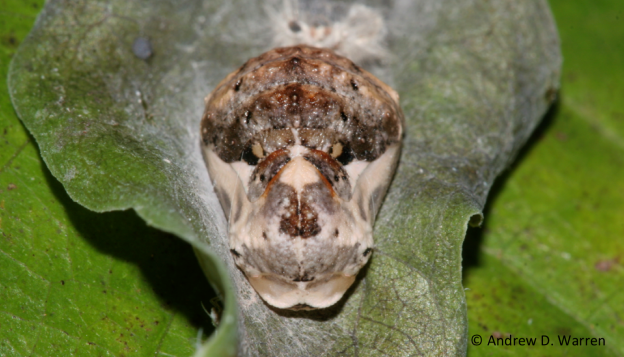In the Americas, there is but a single species of carnivorous butterfly. Unlike other American butterflies whose larvae feed on plants, caterpillars of the Harvester (Feniseca tarquinius) feed only on wooly aphids! Living wooly aphids! Throughout the range of the Harvester in eastern North America, various species of wooly aphids are utilized for food. Here in peninsular Florida, just one species of wooly aphid is used, Neoprociphilus aceris, an aphid that feeds uniquely on spiny greenbrier (Smilax) vines.
The caterpillars are small, slug-like creatures that frequently feed in groups. Locally, It is common to see several caterpillars together, working their way along a greenbrier vine, chomping down all the aphids as they go.

Harvester caterpillars eating wooly aphids, FL: Alachua Co., Gainesville: UF campus at NATL, October 2012
Amazingly, the aphids make no attempt to flee from the approaching caterpillars, instead, they just wait to be the next one to be eaten! Here is what it looks like as a Harvester caterpillar tears into an unsuspecting aphid:

Harvester caterpillar eating a wooly aphid, FL: Alachua Co.: Gainesville, UF campus at NATL, October 2012
In many parts of the range of the Harvester, the caterpillars are myrmecophilous (that is, actively tended by ants), but I’ve never noticed ants tending Harvester larvae in Florida. What’s cooler? Harvester caterpillars produce acoustical signals, the purpose of which remains largely unknown.
So, all of this is pretty amazing! But it gets better. The pupae have been described in the literature, for over a century, as as resembling a monkey’s face. I’m not sure I necessarily see a monkey’s face in the pupa, but I definitely see a face!
Harvester adults are delicate-looking butterflies that remain close to aphid populations. They are most active in the afternoon, and males guard perches in the canopy where they await passing females. These perches are usually 2-4 meters above ground-level, but occasionally, lower perches will be utilized. Today I got lucky, and found this male Harvester guarding a perch at eye-level, allowing me to get some photos:

male Harvester, perched, waiting for passing females, FL: Alachua Co.: Gainesville: UF campus at NATL, 31-X-2013
While there are many related carnivorous butterfly species in Africa and Asia, the Harvester is truly unique among American butterflies!


Great story – particularly for Halloween. The photos are excellent. The photos walked me through the story with a mixture of pleasant admiration, and 1950s horror film terror. “Lovely butterfly….. Wait, no…….This can’t be ………”
Andy,
Something I have wondered recently. Maybe this isn’t the only carnivorous butterfly larvae in North America. I wonder if perhaps Cherry Gall Azure might be also? If it eats the mite galls, does it eat the mite larva inside the gall too? If so, maybe technically it is carnivorous too? Just a thought…
HI Kent,
Many thanks for the comment. Hmmm. Interesting observation. Perhaps the Azure is “accidentally” carnivorous? Definitely a good question for someone to investigate!
I followed this from The Lep Society FB post, so forgive me if I haven’t scoured your blog further to see if you have already covered this.
Here moths rule! I can think of several American non-plant eating moth species off the top of my head, plus some that are “accidentally” carnivorous. The Planthopper-parasite moth (Fulgoraecia exigua), found in Eastern forests, is exactly what it sounds like. Hawai’i has at least two actively carnivorous species, a Cosmopterigidae (Hyposmocoma molluscivora), which as its name implies, eats snails, and several geometrids in the Eupithecia genus that attack fruit flies.
As Kent notes above, it also wouldn’t surprise me if there aren’t more incidents of mainly budwords and frugivoires consuming the larvae inside buds and fruits. A colleague of mine has seen a noctuid going after ground cherries actually prefer the fruit infested by the gelechiid budworm (despite having lower fitness on the infested fruit!).
Here is a compilation of some delightful gifs of the Eupithecia spp.: http://goo.gl/KvHWVV
Thanks for this great review of Lep carnivores and the link! However, as far as I am aware, the Harvester is the only carnivorous butterfly in America. Moths, of course, are a completely different story (one for another post…?). Not to say that there may not be other carnivorous butterflies here, but if so, they are not really known yet… One more note, politically, Hawaii is part of the USA, but biogeographically, it definitely is not part of America!
A really good article. They are closest to the genera Spalgis (Indo-African) and Lachnocnema. We only get the latter in South Africa, and despite lots of searching have never found a larva! So I’m really rather envious of these shots, particularly the one of the aphid meeting it’s end!
Many thanks Steve! We are lucky to have a population of Harvesters just a few feet out the backdoor of our museum, so I get some unique opportunities with them! Come visit in Sept-Oct to see them for yourself! And good luck on finding larvae of your local Lachnocnema!
Hi Andy. I just found your blog. Great!
I believe there is another carnivorous butterfly in Argentina. Phil DeVries and I discovered it turning over rocks in the Quebrada of Humahuaca (Jujuy). There was no evidence of the ants feeding the larvae plant food — like another related species. Both then in the genus Audre. Phil reports on it p.226 in his Riodinid volume on the Costa Rica butterflies.
Great info and pics! I will be sharing your post with my campers in our Spring Break Monster Science Camp (with your permission?)… Ahhhhhhh Real Monsters! I am camp director here at Sci-Port: Louisiana’s Science Center. You mentioned you work at a museum, where are you located? I would love to check out your museum and look for these in the fall.
Of course feel free to share the post! I hope it proves to be useful. I’m at the Florida Museum of Natural History in Gainesville, FL. If you’re ever in the area, be sure to stop by!